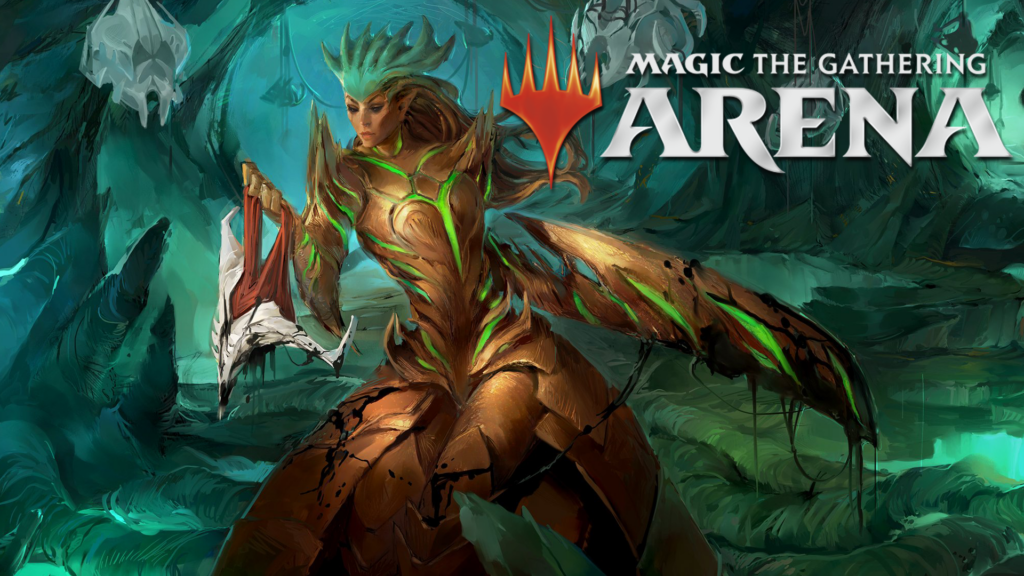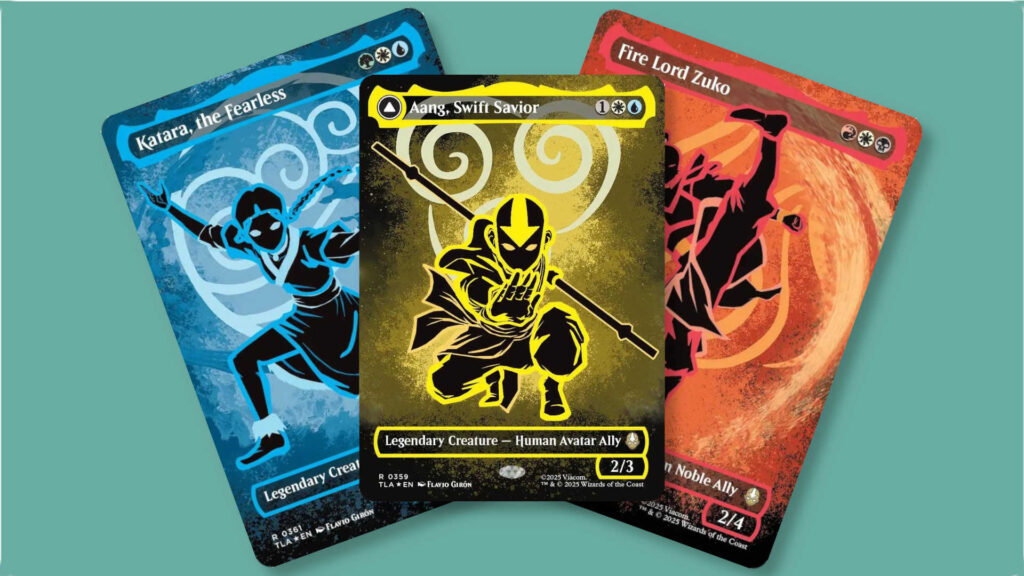Image credit to Wizards of the Coast
If you want to succeed in Standard on Magic Arena (or in paper), it’s hard to beat the flexibility and consistency of black-based midrange decks. You can pair black with any color and get an effective deck out of it, and many color combinations can be built in a variety of ways due to the sheer number of options available. Today we’ll focus on Golgari (black/green) Midrange, which is not only flexible and consistent, but also capable of surprisingly fast starts!
Table of Contents
ToggleWhat’s the Game Plan for Golgari Midrange?
Midrange decks are usually defined by a lot of generically useful and powerful cards moreso than any particular synergies. Depending on the matchup, you may opt to get on the board early to win as quickly as possible, or you may spend your early turns answering your opponent’s threats until you can ensure an eventual, but inevitable, win.
Golgari Midrange specifically gets to run Llanowar Elves, a powerful mana accelerant. Your beefy three- and four-mana threats get even more imposing when they come out a turn early!
The Creatures of Golgari Midrange
There are builds of this deck that don’t even play Llanowar Elves, but in my opinion it’s the biggest card setting Golgari apart from other black midrange decks. You’re not quite as disruptive as something like Dimir (blue/black) but you make up for this by having an important turn-one creature. The metagame is full of cheap removal, so you can’t assume the Elves will always live until turn two, but tempo can swing wildly in your favor if you ramp successfully. Even eating an early removal spell can be helpful sometimes!
Mosswood Dreadknight is a flexible role player. It’s a solid recursive attacker/blocker and source of card advantage. It tends to shine against slower decks, but sometimes you just need something to soak some damage from your opponent’s early creatures. Knowing when to cast each half of this card can be pretty skill-intensive, so expect a bit of a learning curve with this guy.
These three creatures are the bedrock of your threat suite, and pretty much every Golgari Midrange deck runs a mix of them. They’re all somewhat similar in function. They attack well, block well, and provide some sort of value by attacking.
Preacher of the Schism is often best against control but can also gum up the board vs aggro if you’ve already stabilized a bit. Sentinel of the Nameless City presents the fastest clock and can help improve your other creatures. Glissa Sunslayer blocks the best and is the hardest to block, causing major problems for aggro. It also gets random value from its triggered ability, blowing up enchantments or even removing counters from something like a Heartfire Hero that’s racked up a couple.
Moving up the curve, we have our game-ending threats. Sheoldred, the Apocalypse has been a staple of black midrange decks since her debut and has barely slowed down in the last couple of years. Archfiend of the Dross is a more aggressively slanted top-end option that we’re playing here to go along with Unholy Annex (which we’ll talk about shortly). Don’t worry about the oil counters, it’s rare to end up in a situation where this survives that long without dealing lethal damage to your opponent.
Aclazotz, Deepest Betrayal is another one of those cards that kind of does everything. It stabilizes, it generates card advantage, and it refuses to stay dead for long. Five mana is a meaningful cost for a card that doesn’t do anything immediately, though, so we can’t afford to play many copies. I’ve seen some decks running Thrun, Breaker of Silence at the top end instead, which is a totally valid option. Personal preference and metagame shifts should dictate which you play.
The Spells for Golgari Midrange in Standard
Some players have moved away from this Room, but it’s still quite strong. Both halves of the card are individually powerful, providing even more card advantage and a quick clock with the Demon token. That said, enchantment removal has become more common, so I understand why some might want to cut this and Archfiend of the Dross. You almost always at least get your card back from Unholy Annex though, and often you get a lot more than that. Between the Demon token, the Archfiend, and Soulstone Sanctuary you also have plenty of ways to turn the life loss into life drain.
(Please note that Aclazotz, Deepest Betrayal is not a Demon and does not work with Unholy Annex. He looks enough like a Demon where I’ve made that mistake before, but he is in fact a Bat God. Totally different.)
The rest of the spells in the main deck are removal. Cut Down is the go-to removal spell at one mana. While you have a ton of options higher on the mana curve, you can’t really avoid playing this one.
There are even more removal options beyond this, but currently I’m happy with this mix. Anoint with Affliction is important for dealing with creatures with nasty death triggers like Heartfire Hero. It also permanently gets rid of creatures like Abhorrent Oculus that your opponent might be planning to bring back. Go for the Throat is the default removal spell to handle most creatures in the format. This is supplemented by a single copy of Nowhere to Run, which isn’t the most efficient removal spell but does passively prevent cards like Shardmage’s Rescue from causing you headaches.
The Lands
The mana base here is fairly standard for a two-color midrange deck. We have plenty of dual lands to consistently cast spells, and we aren’t so dependent on getting on board early where we can’t afford to run a few lands that enter the battlefield tapped. We also play a total of seven creature lands, increasing our threat density. Restless Cottage is one of the better creature lands in the format (certainly better than the Restless Reef played in Dimir Midrange.) It provides a real clock combined with incidental graveyard hate and even some lifegain. Soulstone Sanctuary only requires a one-time activation to become a creature indefinitely, which is huge. It also counts as a Demon when animated!
The Sideboard
- Duress – A classic disruptive card that deals with so many problematic cards. It’s at its best when taking cards you can’t deal with otherwise (especially board wipes like Sunfall.) That said, counterspells, removal, and reanimation spells are all great targets too. You really want these for the controlling matchups, but they can also come in any time you have relevant hits and worse cards in the main deck you want out (think Unholy Annex // Ritual Chamber against aggro, for example.)
- Ghost Vacuum – The first of three cards in our sideboard that provides graveyard hate. Bring it in against graveyard-centric decks like Azorius Oculus or Squirming Emergence. Pretty straightforward.
- Scavenging Ooze – Good ol’ Scooze isn’t as cheap as Ghost Vacuum, but it’s still pretty effective (and it pays to have multiple versions of this sort of effect, as it forces your opponent to have multiple ways to answer them.) It also grows and gains life, providing additional value in aggressive matchups.
- Tranquil Frillback – Our final graveyard hate piece, but with even more role compression than Scavenging Ooze. It’s never the most efficient option, but its ability to cover so many of your bases makes it a great sideboard piece. There are few matchups where it doesn’t patch a big hole in your game plan (mainly Dimir Midrange) and like Duress it can easily be brought in when you just need something to replace main deck cards that aren’t working out in a given matchup.
- Tear Asunder – Another straightforward card. Bring it in against decks with important artifact/enchantment targets. This can really help against Domain Control, as it deals with Leyline Binding while also removingAtraxa, Grand Unifier in a pinch.
- Blot Out / The End – These both come in against decks with big threats like the aforementioned Atraxa. Blot Out has value in not targeting their threats, which can help against decks that may try to use Shardmage’s Rescue or Royal Treatment for protection (though the higher mana value can make it riskier if you’re on the draw.) The End really nails decks like Azorius Oculus or Domain Control that often rely on multiple copies of only one or two key threats to win a game.
- Choking Miasma – This is basically just for the Jeskai Convoke matchup, though it has value against more fringe decks with similar go-wide strategies.
- Harvester of Misery – Similar to Choking Miasma, but with additional value as a cheap removal spell against other aggressive or midrange decks.
- Nissa, Ascended Animist – If you can resolve this in grindy matchups it often wins the game on its own. Another great option against Domain Control, but you can bring this into your Midrange matchups as well.
Tips and Tricks for Golgari Midrange
- Unholy Annex // Ritual Chamber is the card you’re most likely to cut all four copies of during sideboarding, as it loses a ton of value in the aggressive matchups. Otherwise, if you want to fit several sideboard cards for games two and three, you’re usually going to cut a copy or two of your four-of threats (Llanowar Elves, Mosswood Dreadknight, Archfiend of the Dross, etc.) I’m more willing to cut Llanowar Elves if ramping isn’t as important or if my opponent has a lot of Cut Down.
- One of Golgari Midrange’s strengths is mana efficiency, and Mosswood Dreadknight plays a key role there. Being able to double-spell early helps apply pressure to your opponent. You can also use the Maps from Sentinel of the Nameless City to improve your mana efficiency. Both of these cards can act as four drops when the situation calls for it (casting both halves of Dreadknight or casting Sentinel and cracking the Map on the same turn.)
- If I don’t have a Llanowar Elves ready on turn two and have a Mosswood Dreadknight in hand, I usually want to cast the Adventure first. The main exceptions are if I know my opponent is on an aggro deck and I want a blocker or if I know I just need to apply pressure early to help against decks with better inevitability (Domain Ramp, Squirming Emergence.)
- Cut Down can be used to kill your own Mosswood Dreadknight in response to exile-based removal like Anoint with Affliction or Leyline Binding, allowing you to recast the card draw spell and preserve the Dreadknight in the long run. This play comes up most often in matchups where Cut Down otherwise has few to no relevant targets (again, Domain Ramp.) You should still be removing Cut Down during sideboarding against these decks.
I hope this has been helpful, and thank you for reading! Aetherdrift preview season should be starting right after this article goes up, so next time we’ll be shifting gears a bit to look at some of the strongest cards from the set for Standard!
Want more Standard deck techs? Check out my previous articles on Azorius Oculus and Mono-Red Aggro!




